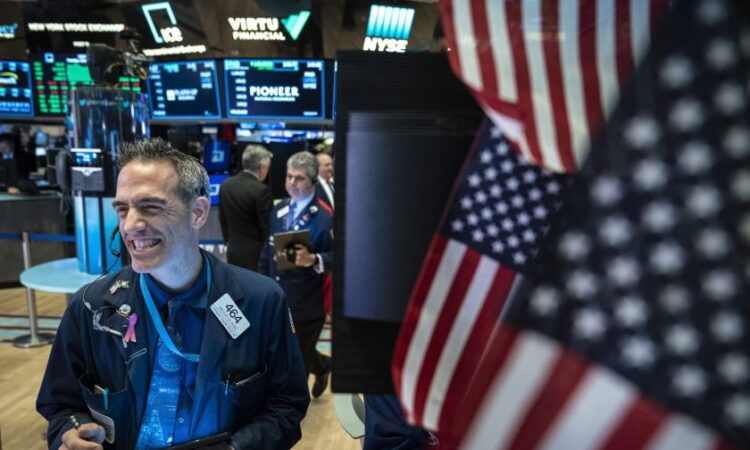Bank of America warned of a mild recession at the beginning of the year. Now, it says the Fed is close to ‘sticking’ a soft landing


Traders and financial professionals work on the floor of the New York Stock Exchange (NYSE) at the closing bell, June 18, 2019, in New York City. Photo by Drew Angerer/Getty Images
Back in January, Bank of America was one of many investment banks that believed the U.S. economy was barreling toward recession. With the Federal Reserve raising interest rates at a breakneck pace to fight inflation, the economy would eventually slow to standstill, the bank warned. But as the year went on, economic data pleasantly surprised Wall Street, leading Bank of America’s chief U.S. economist Michael Gapen to begin shifting his recession forecast.
In June, Gapen argued that instead of facing a mild recession as early as the fourth quarter of 2023, the U.S. was likely to fall into an even more tame “growth recession” in 2024. Then, in August, he scrapped the recession call altogether because of the resilience of the labor market and consumer spending amid the Fed’s aggressive rate hikes. Parroting some Beatles lyrics, Gapen titled the note where he detailed his new, more optimistic forecast: “Imagine no recession, it’s easy if you try.”
Now the veteran economist has turned even more bullish after multiple positive GDP, inflation, and retail sales reports. Consumers’ ability to keep spending even amid rising borrowing costs has convinced Gapen that the vaunted “soft landing”—where the Fed is able to tame inflation without sparking a job-killing recession—is becoming a reality.
“While there are many ways the U.S. economy can evolve, the Fed appears closer to ‘sticking the landing’ than ever,” he wrote in a note to clients Monday.
“An even softer landing”
Gapen explained Monday that his initial call was based simply on history. At the beginning of the year, “surging inflation” and “a Fed that was prepared to err on the side of doing more than less in its fight to bring inflation down” convinced him there would be economic pain ahead. Over 11 periods of rapidly rising interest rates in a 60-year span, only one has resulted in a “soft landing,” making its odds this time around very slim.
Now, though, Gapen says his economic outlook was “too negative,” as both consumers and businesses have shown “significant resilience” to higher rates.
“As the calendar turns to 2024, we make further revisions to our outlook for the U.S. in the direction of an even softer landing,” he wrote Monday, arguing that the Fed’s indicating “the potential beginnings of a rate cut cycle” could boost the economy in 2024.
Bank of America’s new outlook for the U.S. economy includes increased economic growth as well as lower inflation and unemployment. The bank expects GDP growth of 1.2% in 2024, 0.6 percentage points above its prior forecast; an unemployment rate of 4.2%, down from 4.4%; and inflation, as measured by the personal consumption expenditures price index, of 2.2%, down from 2.4%.
Gapen said that the strength of the economy in 2024 will be driven by consumer spending, which accounts for roughly 70% of U.S. GDP. Even though many consumers are pessimistic about their prospects, they continue to spend this holiday season. Retail sales shot up 4.1% from a year ago in November as shoppers splurged on Black Friday and Cyber Monday discounts.
Part of the reason for the resilient consumer spending is “elevated net wealth,” according to Gapen. The stock market’s 23% surge so far this year, as well as years of booming home prices, have made many Americans far richer. The median net worth of U.S. households jumped 37% to $192,900 between 2019 and 2022, according to the Federal Reserve’s Survey of Consumer Finances.
The rise in Americans’ wealth means that as long as the labor market remains strong, consumers are likely to continue their spending spree, Gapen said. And with inflation cooling from its four-decade high of over 9% in June 2022 to just 3.1% in November, a soft landing is likely.
“Incoming data is signaling the U.S. economy can enjoy both modest growth and disinflation simultaneously,” the veteran economist wrote.
The U.S. economy is built different
Falling inflation and resilient growth are not a common combination for most economies, but Gapen believes the U.S. has “structurally changed” over the past decade or so, making it more resilient to higher interest rates. In the housing market, for example, lending standards have improved, and the number of adjustable rate mortgages has plummeted since the Global Financial Crisis (GFC) of 2008. These often risky interest-rate-sensitive mortgages now make up just 9.2% of the market, compared to roughly 35% during the housing boom that led up to the GFC.
At the same time, Gapen noted that many of the drivers of the rise of U.S. inflation over the past few years have been related to supply shocks during the pandemic era, which are now fading.
“Supply-side improvements have helped bring inflation down more rapidly than we and the Fed had assumed previously,” he explained. “It opens the door for inflation to decelerate without putting policymakers in the position of implementing significant demand destruction.”





